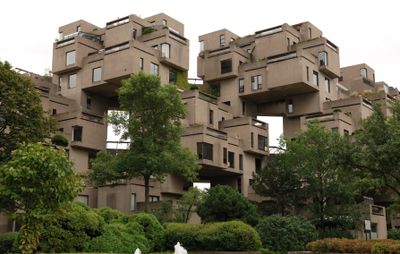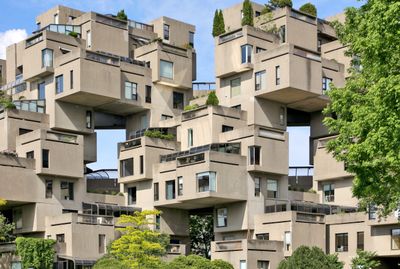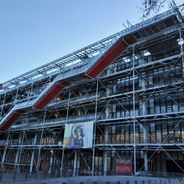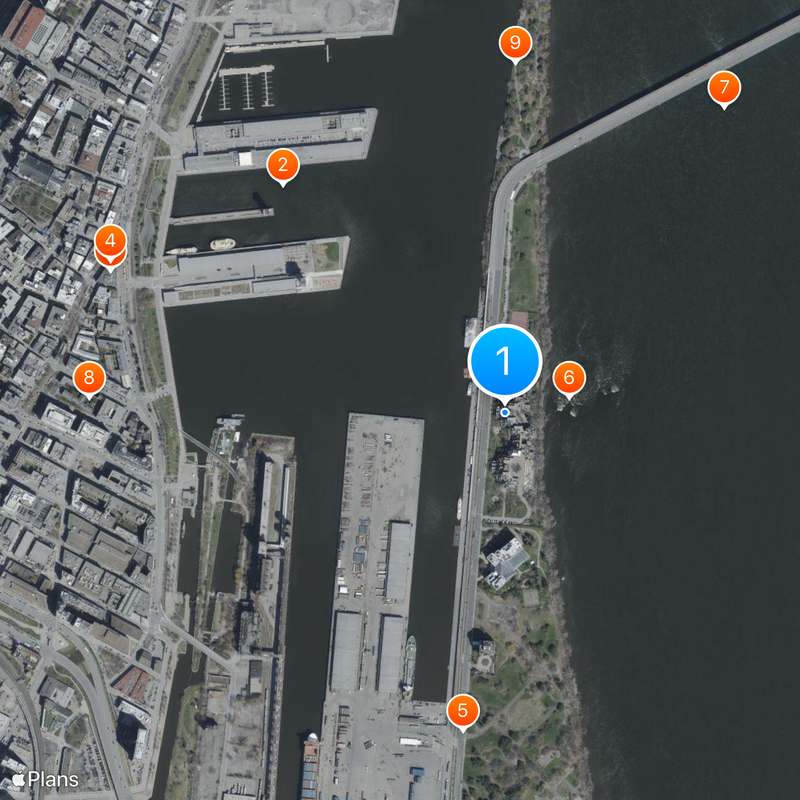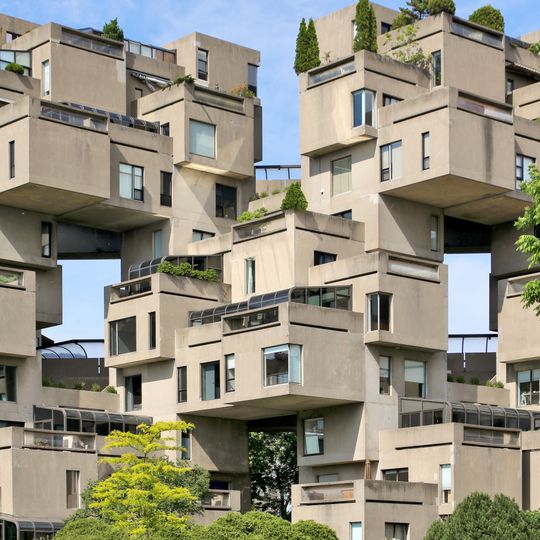
Habitat 67, Brutalist residential complex in Ville-Marie, Canada.
A total of 354 prefabricated concrete modules form 158 apartments distributed across three interconnected pyramidal structures in staggered formations, with each unit receiving different floor plans and multiple terraces through the arrangement of the modules.
Architect Moshe Safdie developed the project as his graduate thesis at McGill University School of Architecture before the Canadian federal government funded construction for the 1967 World's Fair, originally planned with one thousand units but reduced to 158.
The complex served as a vision for dense urban living and demonstrated that residents in high-rise environments could maintain access to private outdoor space and natural light, influencing the North American conversation about urban housing forms.
The building at 2600 Avenue Pierre-Dupuy offers public tours that provide access to select apartments and shared outdoor areas. Reservations are required since it remains an occupied residential building. The nearest metro station is Jean-Drapeau on Île Sainte-Hélène.
Each module weighs around 90 tons and was positioned by crane, with some units comprising up to five modules connected across as many as three levels, allowing residents to use internal staircases within their own apartments.
Location: Ville-Marie
Inception: 1967
Architects: Moshe Safdie
Official opening: 1967
Architectural style: brutalist architecture
Address: 2600, avenue Pierre-Dupuy
Phone: +15148665971
Website: http://habitat67.com
GPS coordinates: 45.50000,-73.54389
Latest update: December 12, 2025 17:24

20th and 21st-century architecture has transformed city centers with structures that push engineering boundaries. Observation towers like the Seattle Space Needle and experimental residential complexes like Habitat 67 in Montreal demonstrate the evolution of construction techniques. Architects have...
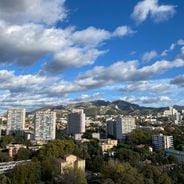
Brutalist architecture emerged in the decades following World War II, producing buildings that challenged conventional design through their honest expression of materials and function. From Le Corbusier's Unité d'Habitation in Marseille to Louis Kahn's National Assembly in Dhaka, these structures...

Expo 67 left a lasting mark on Montreal, with several architectural structures still standing decades after the World Fair closed. The exhibition, held on islands in the Saint Lawrence River, attracted more than 50 million visitors and marked a turning point in the city's development. Many of the...
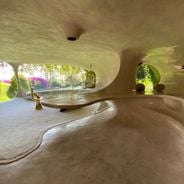
Architecture does not have to follow straight lines and right angles. This collection presents buildings that stand out through their form: domes, spirals, tilted facades or organic structures that recall animals or plants. From Gaudí's mosaic covered works in Barcelona to the stacked concrete cubes...

This collection brings together major works by architect Moshe Safdie, whose practice is distinguished by particular attention to natural light, outdoor spaces, and the integration of buildings into their surroundings. From Montreal to Singapore, through Jerusalem and several American cities, his...
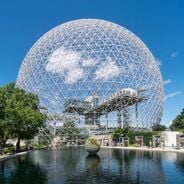
Montreal combines historic sites and cultural institutions along the Saint Lawrence River. The city displays its religious past in structures like Notre-Dame Basilica, whose neo-gothic facade dates to the 1820s, and Saint Joseph's Oratory, a Catholic pilgrimage site on Westmount. Mount Royal rises...
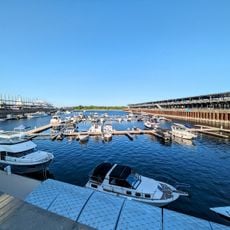
Old Port
648 m
Pointe-à-Callière Museum
853 m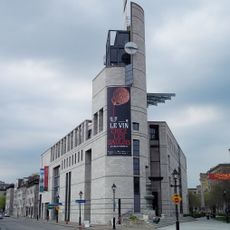
Pointe-à-Callière
859 m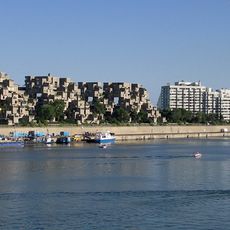
Cité-du-Havre
651 m
Habitat 67
134 m
Pont de la Concorde
764 m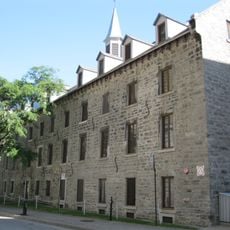
Grey Nuns' Hospital
846 m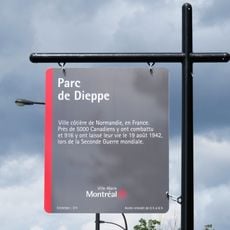
Parc de Dieppe
712 m
Tour du Port de Montréal
387 m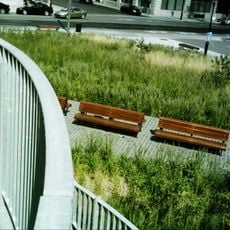
Square des Frères-Charon
849 m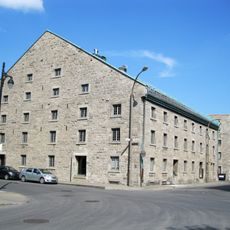
Buchanan Warehouse
875 m
Rapides du Sault Normand
277 m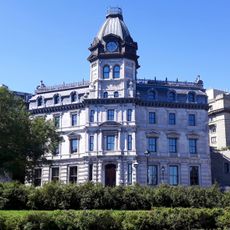
Harbour Commission Building, Montreal
732 m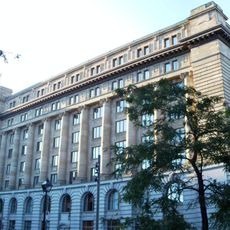
Customs House
873 m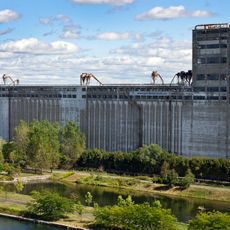
Elevator 5 B1
521 m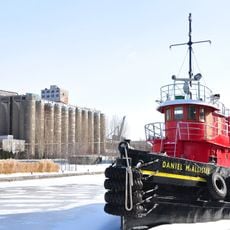
Daniel Mcallister
694 m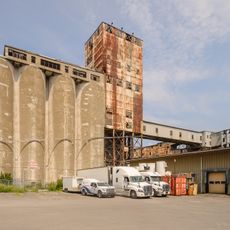
Elevator 5, Annex
689 m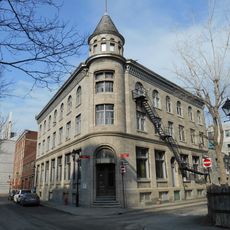
William W. Ogilvie Building
863 m
Edmonstone, Allan and Company Building
755 m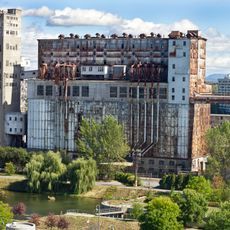
Elevator 5 B
603 m
Entre Nous
857 m
Galerie Nicolas Robert
795 m
Hon. John Young
745 m
Leurs effigies
482 m
L'Île des Commencements
661 m
Projet Mill
781 m
Work of art, sculpture
644 m
Statue, Work of art
872 mVisited this place? Tap the stars to rate it and share your experience / photos with the community! Try now! You can cancel it anytime.
Discover hidden gems everywhere you go!
From secret cafés to breathtaking viewpoints, skip the crowded tourist spots and find places that match your style. Our app makes it easy with voice search, smart filtering, route optimization, and insider tips from travelers worldwide. Download now for the complete mobile experience.

A unique approach to discovering new places❞
— Le Figaro
All the places worth exploring❞
— France Info
A tailor-made excursion in just a few clicks❞
— 20 Minutes
